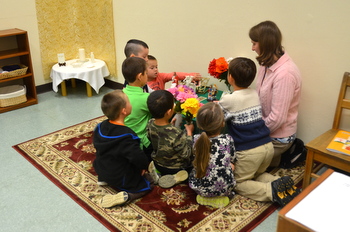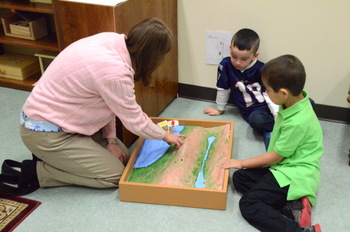Guiding the Way to Christ

Sabrina Arel kneels besides a small altar surrounded by a group of four- and five-year-olds. In quiet tones, she tells the children about the special meal for which the altar is used and shows them the preparations made for it.
“We have a special cup for our meal called a chalice,” she explains.
The children watch attentively, interjecting an occasional ‘what’ or ‘why.’
“What’s a tabernacle?” Alexander, age five, wants to know.
The children are participating in the Catechesis of the Good Shepherd at Holy Family Church, part of Prince of Peace Parish in Lewiston. The Catechesis of the Good Shepherd is a faith formation program which uses the Montessori Method of educating young children. It is a child-centric approach focused on developing creativity and critical thinking skills.
“It’s particularly adapted for very young children, which is not really conceptual but experiential and based on what they handle and what they see, which is how little kids learn,” says Monsignor Marc Caron, pastor. “I think it is very, very well suited for little kids, and often, that’s hard for parishes. We don’t have a way necessarily to respond to little kids age appropriately.”
.JPG)
“The main goal is not that they name everything. The main goal is their relationship with God. That’s the first goal, and then from there, you hope they pick up a few tidbits,” says Sabrina, the catechist.
The children gather in room, called an atrium, with different stations set up throughout. There is a prayer table where the children gather at the beginning and end of each session, a baptism corner where children can learn about the sacrament, and a liturgical area, which includes the altar, a tabernacle, and model vestments in the different liturgical colors.
“Red is the color for Pentecost, and white, white is for celebrations, for feasts like Christmas and Easter,” Sabrina explains to the children. “At Mass, if you pay attention to what the priest wears, you’ll know what time of year it is.”
“It’s green. It’s the growing time now,” says Alexander.
“You’re right. It is,” Sabrina says.
There are also tables where children can create artwork; a section dedicated to the kingdom parables; another focused on the infancy narrative, including the visitation, the Magi, the Nativity, and the adoration of the shepherds; and one in which Jesus the Good Shepherd is the central figure.
“The Good Shepherd is the theme because of the love and protection of the sheep. Children age 3 to 6 are very concerned with being loved and being protected so that’s what we emphasize,” says Sabrina. “Once they understand ‘Jesus loves me,’ they can begin a relationship with Jesus.”

“Is this the earth?” inquires Alexander, pointing to the globe.
“Yes, it is,” answers Sabrina.
“What’s the relation to God?” he asks.
“That’s where Jesus walked,” Sabrina tells him.
While the entire group gathers together at the beginning and the end of the session, in between, the children decide what they want to do. Some choose to color. Others practice pouring different colored liquids. Others head toward the altar or explore the figurines on the prayer table. It’s striking to see the concentration on the children’s faces and to hear how quiet the room becomes.
“If they choose to work with something the whole entire time, they’re allowed to do that. We try not to interfere because, as long as they’re showing signs of being what we call ‘the normalized child’ – silent, concentration, and quiet and controlled movement – then it’s a form of prayer for them,” says Sabrina.
.JPG)
“If you take the materials to a parable, like the Good Shepherd, and you read them the parable and reenact it for them, and then you move away and let them work with the materials, then they can learn; they can reflect on their own level,” says Sabrina. “And they actually have an opportunity as well, while there, to have an encounter with God. God is the ultimate teacher.”
Everything in the atrium is scaled down to the children’s size. The chalice fits in a child’s hand. The altar, which a parishioner, Thomas Hattrup, made to match the pink marble altar in the church, stands only about 18 inches high.
“If it’s too big and too hard for them to use, they get frustrated. It’s to their level. It’s small, and they can use it. It’s a model. I always say it’s a model, a model altar, a model chalice,” explains Sabrina.
.JPG)
“You have to really rethink, in some ways, your idea of what a teacher is because it is not a traditional catechist. You are not instructing in that way. You’re not demanding that they participate in a structured way. You’re presenting and allowing,” says Sabrina.
“Even the way you talk is beautiful, quiet, and relaxing. That sets a tone,” Michelle says to her.
It is a tone that has resonated with both the parents and the children.
.JPG)
“I saw it in action last year, and we had all these kids who loved coming for faith formation,” says Patrick Finn, the parish’s former faith formation director and the driving force being getting the program started at Prince of Peace.
“He loves learning about Jesus, and he loves being with other kids,” says Alexander’s mother, Angela Theberge. “I think he likes the activities the best. He’s always proud of what he comes out with, and he wants to show us. He’s very enthusiastic.”
The Catechesis of the Good Shepherd is labor intensive, requiring more than one adult for each small class. A space that can be dedicated to being an atrium is also needed. Still, those involved say it’s worth it.
“You can see that these kids, these little, itty bitty kids come away with a pretty profound encounter with Jesus,” says Patrick.
“It’s going very, very well,” says Monsignor Caron. “I think it’s a great blessing. I’m very grateful for the catechists. They’re terrific.”










